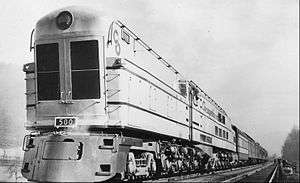Chesapeake and Ohio class M-1
Chesapeake and Ohio class M-1
 |
| Type and origin |
|---|
| Power type |
Steam turbine electric |
|---|
| Builder |
Baldwin Locomotive Works |
|---|
| Serial number |
73079–73081 |
|---|
| Model |
4-8-0-4-8-4 TE |
|---|
| Build date |
1947–1948 |
|---|
| Total produced |
3 |
|---|
|
| Specifications |
|---|
| Configuration |
2-C1+2-C1-B |
|---|
| Gauge |
4 ft 8 1⁄2 in (1,435 mm) |
|---|
| Driver dia. |
40 in (1,016 mm) |
|---|
| Length |
154 ft 3⁄4 in (46.96 m) |
|---|
| Loco weight |
857,000 lb (388.7 tonnes)[1]:161 |
|---|
| Total weight |
617 tonnes (607.3 long tons; 680.1 short tons) |
|---|
| Fuel type |
Coal |
|---|
| Fuel capacity |
29.25 short tons (26.54 t) |
|---|
| Water cap |
25,000 US gallons (95,000 l; 21,000 imp gal) |
|---|
| Boiler pressure |
310 psi (2.14 MPa) |
|---|
|
| Performance figures |
|---|
| Maximum speed |
100 miles per hour (160 km/h) |
|---|
| Power output |
6,000 hp (4,470 kW) (turbine)[2]:141
4,960 hp (3,700 kW) (generators)[3]:109 |
|---|
|
|
|
|
[3]:107-111 |
The Chesapeake and Ohio class M-1 was a fleet of three steam turbine locomotives built by the Baldwin Locomotive Works for the Chesapeake and Ohio Railway in 1947–1948 for service on the Chessie streamliner. As diesel locomotives became more prevalent following World War II, the C&O was one of several railroads loath to abandon coal as a fuel source, and saw steam turbine technology as a possible alternative to diesel. At the time of its construction it was the longest single-unit locomotive in the world.
Design
The design of the M-1 was a collaboration between the C&O, the Baldwin Locomotive Works and Westinghouse.[4]:202 The C&O possessed substantial coal-hauling revenue and was loath to abandon it as a fuel source.[5]:109 Further, C&O's engineering staff expressed concern that oil reserves would be exhausted within 25-30 years.[3]:109 The locomotive contained a single Westinghouse turbine which in turn drove four direct current (DC) generators, mounted in pairs.[6]:116 Each generator produced 1,000 kilowatts (1,300 hp), and the four generators collectively turned eight traction motors.[1]:161
Defying the usual convention, the M-1 was arranged with its boiler in the rear and the coal bunker in the front. The turbine-generator system meant that the M-1 contained no cylinders. The reduced number of moving parts meant that, in theory, the M1 required far less maintenance than a conventional steam locomotive. Its designers predicted that it could make the run from Washington to Cincinnati—and back—without servicing.[3]:110-111
The locomotive's throttle included eleven settings, ranging from one (idling) to eleven (full speed). The locomotive's cruising speed was 70 miles per hour (110 km/h), at which point the throttle was on "seven." During a trial run with a reporter from Popular Mechanics aboard, a C&O engineer expressed his dissatisfaction with a local speed limit of 75 miles per hour (121 km/h), noting that he would "sure like to be able to pull it back to eleven!"[3]:110; 252 Not including research and development, the three locomotives cost US$1.6 million.[7]:45
Career
The C&O cancelled the Chessie in 1948, before it ran in revenue service, depriving the M-1s of their reason for existence. The M-1s themselves proved expensive to operate and mechanically unreliable.[4]:202 They spent their short careers operating between Clifton Forge and Charlottesville, Virginia.[8]:62 The locomotives were scrapped in 1950.[2]:141
See also
References
- 1 2 Lamb, J. Parker (2003). Perfecting the American Steam Locomotive. Bloomington: Indiana University Press. ISBN 0253342198. OCLC 50858989.
- 1 2 Solomon, Brian (1998). American Steam Locomotive. Osceola, WI: Motorbooks International. ISBN 0760303363. OCLC 38132717.
- 1 2 3 4 5 Railton, Arthur R. (March 1948). "Chessie Has That New Look". Popular Mechanics.
- 1 2 Schramm, Jeffrey W. (2010). Out of Steam: Dieselization and American Railroads, 1920-1960. Bethlehem: Lehigh University Press. ISBN 9780982131374. OCLC 521744662.
- ↑ Grant, H. Roger (2005). The Railroad: The Life Story of a Technology. Westport: Greenwood Press. ISBN 0313330794. OCLC 57143252.
- ↑ Solomon, Brian (2010). Baldwin Locomotives. Minneapolis, MN, USA: Voyageur Press. ISBN 9780760335895.
- ↑ George, Geoffrey H. (July 1968). "This Was The Train That Was (But Never Was)". Trains. Vol. 28 no. 9.
- ↑ Casto, James E (2006). The Chesapeake and Ohio Railway. Charleston, SC: Arcadia Publishing. ISBN 9780738543345. OCLC 123954873.
External links